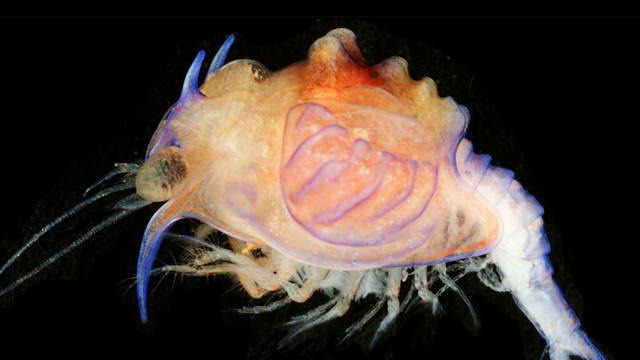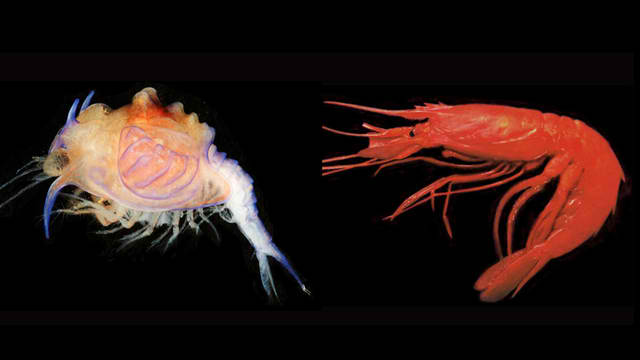It looks like you're using an Ad Blocker.
Please white-list or disable AboveTopSecret.com in your ad-blocking tool.
Thank you.
Some features of ATS will be disabled while you continue to use an ad-blocker.
6
share:
This is a pretty interesting story showing how modern science can solve old mysteries. It's amazing how much a transformation can take place in
creatures in their lifetime. When you look at the difference in the larva and the adult form, it's easy to see how it would be difficult to identify
what the larva would be when it reached adulthood.
io9.com...


io9.com...
For almost two hundred years, Cerataspis monstrosa — the otherworldly looking "monster larva" pictured here — has been turning up in the guts of everything from dolphins to tuna. But for as widely known as this larval creature is, its adult counterpart has managed to remain a mystery.

Now, with the help of DNA analysis, biologists at George Washington University think they have C. monstrosa's adult identity pegged.
C. monstrosa is something of a puzzle from a biogeographical standpoint. It's regarded by marine biologists as rare, but it's been found in the guts of sea creatures all over the world. For 180 years, the monster larva has been turning up at "mid-water" depths, so-called for existing well above the sea floor, but still a fair distance beneath the ocean surface. But finding the fully matured form of sea creatures like C. monstrosa is notoriously complicated — not only do adult counterparts often look nothing like their larval forms, they can also thrive in entirely different ocean habitats. Biologists have long suspected this to be the case with C. monstrosa, but proving it by identifying its fully matured form has proven difficult.
That's where biologist Keith Crandall comes in. Previous studies had pointed to a link between C. monstrosa and a species of deep-sea shrimp called Plesiopenaeus armatus. Using DNA data collected over the course of several years, Crandall and his colleagues were able to compare multiple genes from both organisms to confirm the larva and adult are, in fact, the same species

reply to post by lurkatron
lol. No it's MONSTROSA. Which kind of reminds me of Monsanto for some wierd reason. Maybe because I'm trying to quit coffee for a couple of weeks.
Anyway this is a cool find. I love studying insects and have long noticed the larval forms often bear no resemblance to their adult forms nor abide in the same habitats or eat the same foods, if the adults even eat at all. It does not surprise me there are some creatures who have managed to stump the scientists when it comes to linking the larva and intermediate forms to the final adult form.
lol. No it's MONSTROSA. Which kind of reminds me of Monsanto for some wierd reason. Maybe because I'm trying to quit coffee for a couple of weeks.
Anyway this is a cool find. I love studying insects and have long noticed the larval forms often bear no resemblance to their adult forms nor abide in the same habitats or eat the same foods, if the adults even eat at all. It does not surprise me there are some creatures who have managed to stump the scientists when it comes to linking the larva and intermediate forms to the final adult form.
Thats just one of the potentially hundreds of larvae!
... I wanna see the mother 0.0
... I wanna see the mother 0.0
new topics
-
Paradox of Progress
Ancient & Lost Civilizations: 4 hours ago -
Joe Biden gives the USA's Highest Civilian Honor Award to Hillary Clinton and George Soros.
US Political Madness: 6 hours ago -
Winter Storm
Fragile Earth: 7 hours ago -
Biden Face Planted Somewhere
Politicians & People: 9 hours ago -
A great artist and storyteller, for kids of all ages
General Entertainment: 9 hours ago
top topics
-
Joe Biden gives the USA's Highest Civilian Honor Award to Hillary Clinton and George Soros.
US Political Madness: 6 hours ago, 13 flags -
What Is 'Quad Demic'? Mask Mandate Returns In These US States
Diseases and Pandemics: 13 hours ago, 11 flags -
Volcano Watch 2025
Fragile Earth: 15 hours ago, 8 flags -
The Future of fashion .
Social Issues and Civil Unrest: 14 hours ago, 8 flags -
Winter Storm
Fragile Earth: 7 hours ago, 7 flags -
Bin Cyber Junk…
Short Stories: 14 hours ago, 6 flags -
Biden Face Planted Somewhere
Politicians & People: 9 hours ago, 5 flags -
A great artist and storyteller, for kids of all ages
General Entertainment: 9 hours ago, 5 flags -
Paradox of Progress
Ancient & Lost Civilizations: 4 hours ago, 5 flags -
The Undertones - Teenage Kicks
Music: 15 hours ago, 3 flags
6
